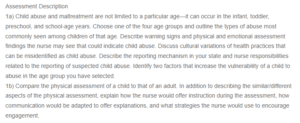Physical Assessment
Nurses have the responsibility to assess both children and adults for abuse. Various aspects of physical assessment are familiar and different during child and adult assessment. In most cases, biological assessments of both children and adults are similar. The physical evaluation of a child and an adult will focus on physical clues of abuse; whether a physical evaluation is conducted on a child or an adult, the nurse will focus on identifying swelling, scratches, or bruising marks on the victim’s body. The nurse must also assess the victim’s arms to determine defense marks and bruises. The nurse can also set the child or adult for bodily fractures. Other similar physical assessments can include observing the physical appearance of the child or an adult. In this assessment, the nurse can watch for signs of sleepiness or unconsciousness.
Do you need help with your assignment?
However, there are significant differences between the physical assessment of a child and an adult based on how the assessing nurse offers instruction, evaluating how they communicate, and the strategies they employ to encourage engagement. During physical assessment, a child may experience fear, anxiety, shame, sleep, or move around. The examining nurse may seek to establish a rapport to enable the child to connect with the nurse (Srinath et al., 2019). However, the nurse must strive to develop a confidential and trusting relationship with an adult patient so that the patient can feel comfortable during the physical assessment. The nurse must ensure that the patient feels respected, listened to, and heard. The nurse can also ensure that the decision to conduct the physical assessment is based on the patient’s views. Research has established that shared decision-making during care delivery improves patient engagement throughout care(Granados-Santiago et al., 2020).
References
Granados-Santiago, M., Valenza, M. C., López-López, L., Prados-Román, E., Rodríguez-Torres, J., & Cabrera-Martos, I. (2020). Shared decision-making and patient engagement program during acute exacerbation of COPD hospitalization: A randomized control trial. Patient Education and Counseling, 103(4), 702–708. https://doi.org/10.1016/J.PEC.2019.12.004
Srinath, S., Jacob, P., Sharma, E., & Gautam, A. (2019). Clinical Practice Guidelines for Assessment of Children and Adolescents. Indian Journal of Psychiatry, 61(Suppl 2), 158. https://doi.org/10.4103/PSYCHIATRY.INDIANJPSYCHIATRY_580_18
ORDER A PLAGIARISM-FREE PAPER HERE
We’ll write everything from scratch
Question

Physical Assessment
Assessment Description
1a) Child abuse and maltreatment are not limited to a particular age—it can occur in the infant, toddler, preschool, and school-age years. Choose one of the four age groups and outline the types of abuse most commonly seen among children of that age. Describe warning signs and physical and emotional assessment findings the nurse may see that could indicate child abuse. Discuss cultural variations of health practices that can be misidentified as child abuse. Describe the reporting mechanism in your state and nurse responsibilities related to the reporting of suspected child abuse. Identify two factors that increase the vulnerability of a child to abuse in the age group you have selected.
1b) Compare the physical assessment of a child to that of an adult. In addition to describing the similar/different aspects of the physical evaluation, explain how the nurse would offer instruction in the assessment, how communication would be adapted to offer explanations, and what strategies the nurse would use to encourage engagement.

